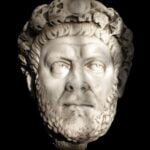Name “Eternal City” (Urbs aeterna) was finally given to Rome by Emperor Hadrian, but he had already used it before 1st-century writer Tibullus in “Elegies”. Even Ovid and Livy mentioned the eternity of Rome.
After the fall of Nero in 68 CE, the faith of the Roman people in the uniqueness of the Roman state, which was often ruled by tyrants, declined. Already Flavian emperors depicted on their coins the goddess Aeternitas holding the sun and moon in her hands – a symbol of the infinity of Roman rule. This was to revive the spirit of the Romans and build the belief that the Roman Empire is unique in the scale of history. The rise of the Roman Empire created the need to spread propaganda and strengthen faith in the power of the Roman state.
Reigning in the 2nd century CE, Hadrian formalized the cult of Roma Aeterna and changed the name of Parilia to Romea. The words ROMA AETERNA, meaning “Eternal Rome”, began to be minted on the coins. In the 1st century CE, Silius Italicus – a Roman poet – stated:
So long as seamonsters shall swim the deep and stars shine in the sky and the sun rise on the Indian shore, Rome shall rule, and there shall be no end to her rule throughout the ages.
– Silius Italicus, Punica, 7.469
In Rome, there was also the topos of translatio imperii, assuming that power over the world was passed on to successive states. And so the Assyrians were replaced by the Medes, those by the Persians; then came the Macedonians, from whom the empire was taken over by the Romans. In this 4+1 model, the Romans are the 5th and last power which is universal and eternal.







